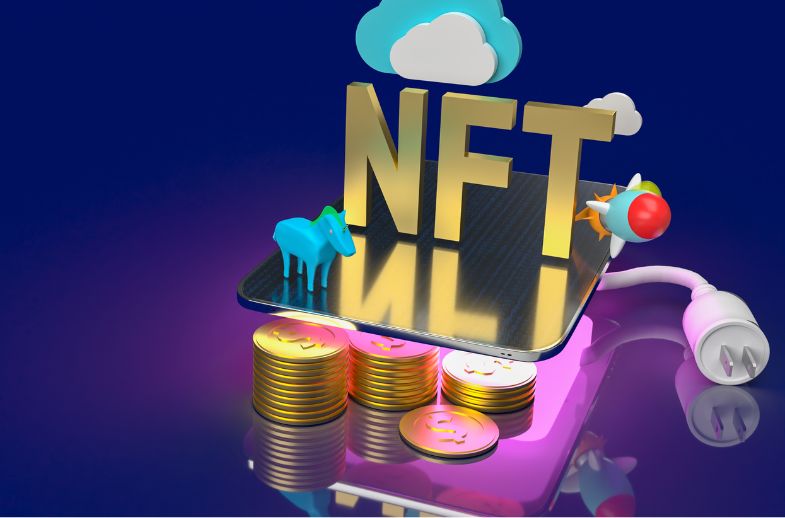What Are NFTs? A Beginner’s Guide

Non-Fungible Tokens, or simply NFTs, are a new acronym in the emerging world of technology. Technology is continuously developing and reshaping individuals’ lives through its working algorithms. NFTs seem like technical jargon, but they are not. They are fascinating and relevant to the world we live in today. So, what are NFTs in actuality, and why are they causing a stir in art? If these questions come to your head, you are not alone.
This article will provide you with a beginner guide to NFTs.
What are NFTs?
NFTs, or Non-Fungible Tokens, are a relatively new and unique form of digital asset that has accumulated noteworthy attention in various industries. In essence, NFTs are digital certificates of ownership stored on a decentralized and secure digital ledger blockchain. They represent something unique and unusual, like a rare painting or a specific trading card.
A Beginner’s Guide to NFTs
In this growing and developing world, knowing the existence and worth of NFTs is very important to benefit yourself in a financial way. Here, you will get a complete beginner’s guide to NFTs:
How NFTs Work
NFTs are created, bought, and sold on specialized online platforms known as NFT marketplaces. Ethereum, a popular blockchain network, is often used for creating NFTs due to its ability to support smart contracts. Smart contracts involve self-executing contracts with the terms of the agreement written into code that is more secure than any other contract. This contract-based mechanism allows artists, creators, and developers to fix specific rules into their NFTs, such as receiving a percentage of future sales whenever the NFT changes hands.
When someone purchases an NFT, they essentially acquire ownership of a digital certificate representing the specific item. This ownership is cryptographically secured, which makes it easy to verify the authenticity and originality of the digital asset. This is used as a protection layer against any type of fraud. The buyer’s ownership is recorded on the blockchain, making it publicly accessible and transparent.
The Appeal of NFTs
Digital Ownership: NFTs offer a way to own and trade digital assets in a way that wasn’t possible before. This unique way of owning assets appeals to collectors who value owning unique items, whether they’re digital art pieces or virtual collectibles.
Supporting Creators: They enable creators, including artists, musicians, and writers, to monetize their work more directly than any other platform. With traditional digital content, piracy and unauthorized sharing can significantly impact the annual revenue of a business or individual. NFTs provide a way to prove ownership and earn royalties each time the NFT is resold.
Scarcity and Exclusivity: Non-fungible tokens capitalize on the human desire for exclusivity. The limited nature of many NFTs increases their received value, similar to owning a rare physical collectible.
Intersecting Technology and Art: They have bridged the gap between technology and art by attracting individuals who are interested in both fields. The digital nature of NFTs allows artists to do something innovative, interactive, and dynamic to make their art unique and valuable.

NFTs in Practice
Digital Art: Digital art sales have become synonymous with NFTs. Artists can tokenize their creations, selling them as NFTs on platforms like OpenSea, Rarible, or Foundation. Notable examples include Beeple’s $69 million sale of “Everydays: The First 5000 Days” and the emergence of crypto art communities.
Gaming: NFTs have made an influence impact on the gaming industry. Players can own, trade, and use in-game items as NFTs. This provides gamers with actual ownership and the ability to monetize their in-game achievements. In this way, gamers are able to earn money while killing their free time.
Collectibles: Digital collectibles have been revived by NFTs. These can range from virtual trading cards to virtual pets. A prime example is the NBA Top Shot, which offers officially licensed NBA collectible highlights.
Virtual Real Estate: Some virtual worlds allow users to buy, sell, and build on virtual land as NFTs. This has created a virtual real estate market where users can speculate and develop.
Criticisms and Challenges
While NFTs have brought innovation and new opportunities, they have also faced criticisms. One primary concern is their environmental impact, as platforms like Ethereum rely on energy-intensive processes. Moreover, the hype around NFTs resulted in a rise in fraudulent schemes and copyright conflicts.
The Future of NFTs
The future of NFTs is exciting and full of potential. As the technology matures, we may expect increased integration of NFTs into various industries, including music, fashion, education, and more. The development of more eco-friendly blockchain solutions might also address the environmental concerns associated with NFTs.
Conclusion
NFTs represent a fascinating intersection of technology, art, and ownership. The ability of NFTs to tokenize digital assets has revolutionized how we think and interact with creative works and virtual goods. Whether you are an artist looking to monetize your creations or someone interested in collecting digital art, NFTs have undoubtedly made an influential impact. This is the way they revolutionized thinking about ownership in the digital age. You are allowed to make a digital asset on a specific platform to sell it and make money for your own survival and thrive in the industry.






